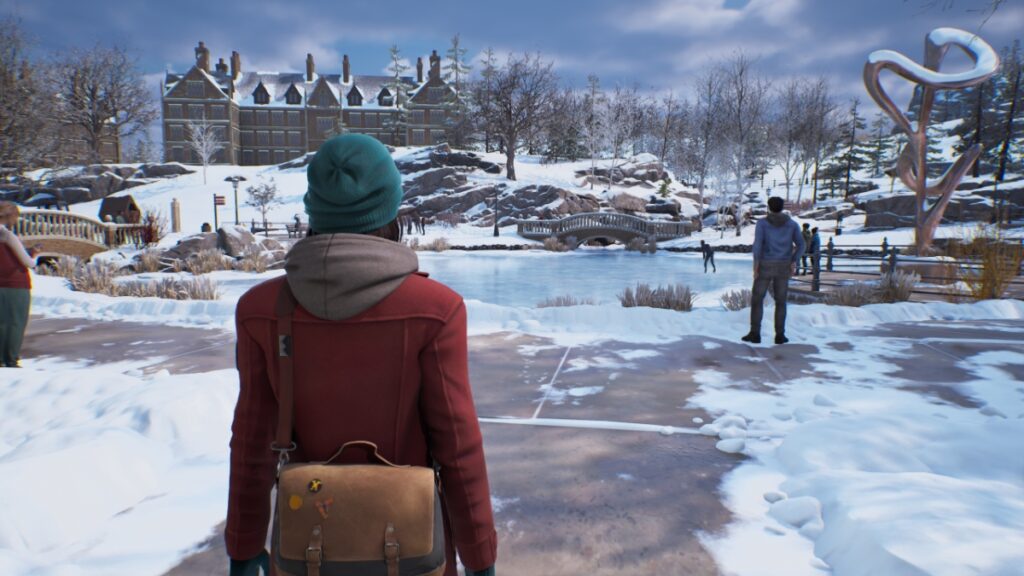Skip To...
My chief frustration with Life Is Strange: Double Exposure is that my word count is limited, so I can’t write 30 pages gushing about its virtues. I can’t write 60 more analyzing its symbols and twists, critiquing its politics, and cooing over its soundtrack. I met Max Caulfield here, with her journey already well underway, but joining the franchise in medias res didn’t hurt. Double Exposure‘s vision is so (ironically) singular and artful that you don’t need to have played the previous games to appreciate what Deck Nine Games has accomplished.
Life Is Strange: Double Exposure Review

Life Is Strange: Double Exposure is a third-person narrative adventure game with an emphasis on conversation and choice-making, which is like saying Super Mario Bros. is about a jumpy plumber. Its five acts take 12-15 hours depending on your thoroughness. That gives you ample time to explore Caledon University, make friends (and enemies) with its staff and students, take pictures, and solve / prevent a killing in two parallel timelines. It’s a high-concept supernatural mystery about what friendship and empathy can look like for traumatized people, but (in defiance of all the odds) it isn’t pretentious.
Story: Of Safi and Storms

Max Caulfield once had the power to rewind time. She used it to save the town of Arcadia Bay from a supernatural storm but only at the cost of her friend Chloe’s life. Now Max is the photographer-in-residence at Caledon University, and a second death has struck. After discovering her friend Safi dead in the snow, Max tries to use her rewind ability to save her. Instead of sending her back in time, reality splits, creating two parallel timelines. In one, Safi’s death occurred; in the other, she lives. So begins Max’s investigation through two realities.
Double Exposure interweaves multiple narratives, dancing back and forth between characters and themes with the dexterity of a concert pianist. Within a handful of conversations, its cast felt as familiar as those that inhabit my favorite sitcoms. It’s homey but never Hallmark, always more than the slice of 21st-century Americana that such games often boil down to. Double exposure is a photography technique that combines two shots to create a unique layering effect, and that’s how Life Is Strange treats its plots too. Scratch the dialogue, and you’ll find another layer of meaning beneath your nail.

It takes an exceptional pen game to explore difficult subjects without succumbing to preachiness, superficialities, or self-satisfied back-patting. Double Exposure is exceptional not because it’s “a game with something to say,” but because it says that something without condescending to the player or demanding some particular response. It explores transphobia, suicide, and grief, but those aren’t what it’s about. Life Is Strange is about the impossibility of touching the world without leaving fingerprints.
Whether you’re breaking into an abandoned bowling alley for a photo op or sharing a cup of cocoa during a late-night astronomy session, the game always finds an empathetic perspective. This keeps the supernatural moments grounded. It also makes the creeping weirdness of Max’s powers and Safi’s mysterious death more believable. It also makes everything more painful. Double Exposure is funny and searing in equal measure.
Gameplay: Marks and Annotations

You spend most of your time in Life Is Strange: Double Exposure exploring Caledon University and talking to its staff and students. Most conversations offer a handful of choices, the vast majority of which pay off in satisfying ways. Some choices are small, like which cheesy pick-up line you use or which mug you drink from. Others completely change the narrative trajectory, condemning characters to fates they’d otherwise escape. Though less complex than Baldur’s Gate 3 or Disco Elysium, it’s equally compelling.
Take pictures. Read notes. Chat up your lit professor and local barista for their thoughts on the recent homicide. Once Max unlocks her new power, you can even swap timelines. In Dead World, Safi is dead. In Living World, whatever happened to her on that snowy overlook simply…didn’t. Where it occurred, the trauma of Safi’s death changed everything. You can often play the Living and Dead World versions of characters off their counterparts, using the knowledge you gain in one reality as leverage in the other. It’s not the first time I’ve seen this mechanic, but it might be the best.

In one small moment, Max gets the chance to write a message commemorating Safi, but when the moment arrived, I couldn’t. My Max recapped the marker and put it back. It was a physical gesture so cosmically insignificant that it couldn’t help but throw a spotlight on the agony of Max’s grief. I started crying, the third time of maybe five that Double Exposure wrung waterworks from me. It’s a mechanically simple game, consisting of walking around, talking to people, and inspecting things that are none of your business. Yet it prepares these simple ingredients with the reverence of a lifelong sushi chef.
Each chapter sets you loose somewhere in or around Caledon, and by the end of the game, the university is as much a character as Moses or Amanda. Admin, the Fine Arts Building, and the North Quad are packed with people to talk to, paintings to inspect, and collectibles to collect. Focusing on a handful of mechanics allowed Deck Nine Games to polish everything to a mirror finish, and all of it feeds the story. Despite photography being one of the game’s main symbols (and Max’s literal job), you don’t spend a ton of time behind a camera. If anything, that makes your photo ops feel more significant.
Graphics & Audio: The Human Museum

Outside on the North Quad, some students skate the frozen pond, while others huddle together, gossiping about Caledon’s not-so-secret society. Meanwhile, inside the Fine Arts Building, Max admires some emaciated statues. The thinness of their limbs only adds drama to their gestures. It’s like the weight of any stray motion might break them. Absorbed by the art, Max’s face doesn’t change, even when the conversation she’s eavesdropping on turns to the subject of someone she knows.
Max Caulfield is one of the best protagonists of the decade, thanks in part to a luminous vocal and motion capture performance. Wrap the right words in the wrong aesthetic and even the most artful writing will dissolve like sugar in water. Double Exposure marries the right words to the right aesthetic. Its models and animations convey real emotion, but they’re stylized just enough to avoid plowing headfirst into the Uncanny Valley. Watching Max interact with her friends is a genuine pleasure.

From the sketchy white outline that highlights interactable objects to the firefly-like particles around reality portals, the game favors clean but modest SFX. It helps to reel in the plot’s wilder fantasy elements, and I was thankful for the restraint. Life Is Strange: Double Exposure is the kind of game that can fly apart under the centrifugal force of its ideas, but its graphics and audio exert their own gravity, holding it all together. This is the happiest I’ve been with a cast of voice actors since BG3.
Last, there’s the music. With its catalog of original and licensed tunes, the game somehow strikes a complimentary chord in every scene. You’re even offered tailored moments of reflection, allowing Max to vibe along with a cutscene as you absorb the tunes. It’s 100 cc of vibes, straight to the jugular, and I can’t recall another game with music that exerted such a hypnotic effect. Life Is Strange: Double Exposure may be the first game to lure me back for another playthrough with its soundtrack alone.
Conclusion: Max Potential

I experienced no notable bugs and no crashes during my time with the game. Life Is Strange: Double Exposure is the first 10 I’ve given, but I give it with confidence. If all you want is a cool supernatural mystery, it offers that. If you want more, it offers that, too. It’s not flawless, but it’s so good the flaws don’t matter, at least to me. If you’re a human being and a fan of the genre, I couldn’t recommend Double Exposure more enthusiastically. You can see what Max is up to on PC, PlayStation 5, and Xbox Series X/S on October 29.
Review copy provided by Publisher.
Life Is Strange: Double Exposure (PC Reviewed)
A staggering achievement of narrative, artistic, and emotional weight, Life: Is Strange: Double Exposure is an art piece that rivals the best in its genre for poignancy and style.
Pros
- Deep and layered storytelling
- Captivating performances
- Satisfying and significant choices
Cons
- You can only play it for the first time once








